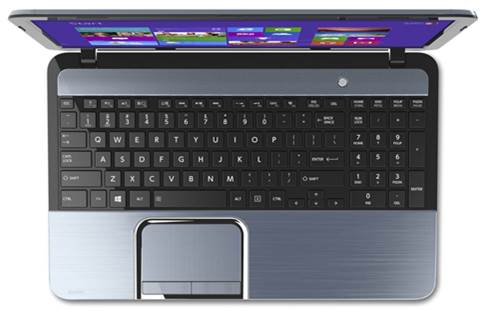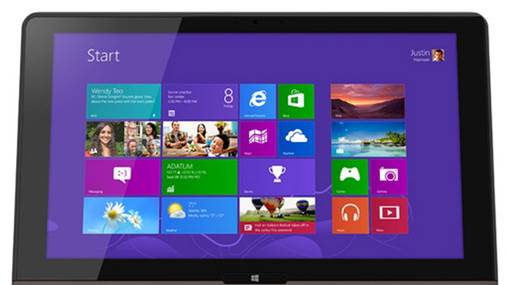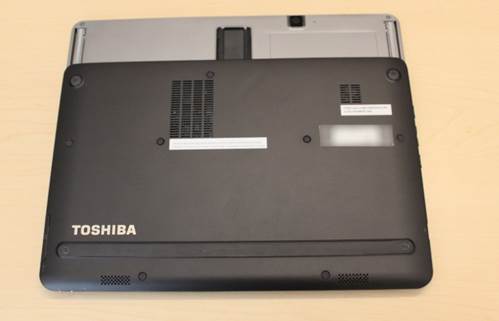Keyboard and trackpad
When we first tried the U925t, we said that
it had a keyboard that was larger than most slider keyboards we have seen. And
that's true; an inherent issue with this form factor is that when the screen is
propped up, the joint around the back occupies the space of the useful keyboard
tray, which makes the keyboard area unusually tight. We still say that the
U925t tablet has a better keyboard than the new MSI Slider S20, but it does not
express much. The layout here still feels cramped compared to the XPS 12, or
any other ultraportable with fully usable keyboard tray.

In
spite of somewhat shallow keys, they have a soft surface that feels good under
the fingertips.
All in all, we were able to type the main
part of this review on it, but made a lot of spelling mistakes along the way.
Unfortunately, the propped-up screen took up too much space, it is due to with
a little more space this would likely be a great typing experience. In spite of
somewhat shallow keys, they have a soft surface that feels good under the
fingertips, and we like the way the keyboard produces quite little sound, even
when you are typing fast. The soft background lighting is also a good point.
(You can disable it at any time by pressing Fn-Z).

When
the screen is propped up, the joint around the back occupies the space of the
useful keyboard tray, which makes the keyboard area unusually tight.
If you think the keyboard is cramped,
imagine how small the touchpad is. However, it is wide; just is not very high.
Mainly it is a problem when you're trying to click the preset- touch button
(which you can use if you're in File Explorer or any other desktop applications
requiring accuracy). In that scenario, it's hard to fit both your thumb and
index finger on the trackpad at the same time; your index finger may sweep over
the top of the touchpad, and type exactly the spacebar.
Fortunately, the touchpad is large enough
so that you are able to comfortably roll two fingers, which works smoothly on
this device. We are sure you will not need the touchpad for pinch-to-zoom
because as you know, you can only use the touch screen for that.
Screen and sound
In addition to the protection of the
Gorilla Glass, the 12.5-inch screen provides some good viewing angles through
IPS technology. Pursuant to the fact that this is not the type of computer you
can gather around with your friends, you may appreciate the best viewing angles
when using the PC in your lap. Using it this way, we had quite a lot of leeway
when we were adjusting the screen. In terms of 1,366x768 resolutions, it's
pretty standard between Windows computers, especially the models with small
screens. It's completely adequate for watching movies and working, but it is
worth taking notice that there are more and more 1080p PCs, including the Dell
XPS 12 and the Acer Aspire S7, a 13-inch Ultrabook with a touch screen. Indeed,
we happened to have both of these computers, and as you might guess, their
screens look more vivid, and the remarkable difference shows in the desktop and
in the Modern UI of Microsoft.

The
12.5-inch Gorilla Glass screen provides some good viewing angles through IPS
technology.
The U925t’s two speakers are placed on the
underside of the device, just below the place of laying the palm. As you may
have thought, based on the size of the laptop and the location of the speakers,
the sound never becomes very loud, even at the maximum settings. Like many
other laptops, the sound is certainly tiny; with cut-off bass notes. The
special low tones sound was heard as it was distorted at maximum volume, so you
may want to keep the volume at a more moderate setting, even if it means
experiencing the softer sound.

The
U925t’s two speakers are placed on the underside of the device, just below the
place of laying the palm.
Performance and battery life
Toshiba
Satellite U925t (Core i5-3317U 1.7GHz, Intel HD 4000)
·
PCMark7: 4,381
·
3DMark06: 4,210
·
3DMark11: E989 / P563
·
ATTO (top disk speeds): 521MB/s (reads); 265
MB/s (writes)
Dell XPS 12 (1.7GHz Core i5-3317U, Intel HD 4000)
·
PCMark7: 4,673
·
3DMark06: 4,520
·
3DMark11: N/A
·
ATTO (top disk speeds): 516 MB/s (reads); 263
MB/s (writes)
Lenovo IdeaPad Yoga 13 (1.7GHz Core i5-3317U, Intel HD 4000)
·
PCMark7: 4,422
·
3DMark06: 4,415
·
3DMark11: E917 / P572
·
ATTO (top disk speeds): 278MB/s (reads); 263
MB/s (writes)
Acer Aspire S7 (2.4GHz Core i7-3517U, Intel HD 4000)
·
PCMark7: 5,011
·
3DMark06: 4,918
·
3DMark11: E1035 / P620 / X208
·
ATTO (top disk speeds): 934 MB/s (reads); 686
MB/s (writes)
This may be the
easiest performance comparisons we ever had. Every Ultrabook is listed in the
table above running Windows 8, and three of them have the same Ivy Bridge Core
i5 processor. All have the Intel’s latest integrated graphics solution, the HD
4000 chipset. The benchmark scores in PCMark7, 3DMark06 and 3DMark11 are equal.
One exception is the Acer Aspire S7 that we checked with a Core i7 CPU and RAID
0 SSD setting. Therefore, there are not many signs to show that the U925t is
either faster or slower than the rivals. Its highest drive speeds measured by
ATTO, were very close to what we had with the XPS 12. Its read speeds were
remarkably faster than the speeds of Yoga 13 (512MB/s vs. 278MB/s), but that
appears to be more related to the Yoga, because the XPS 12 also got read speeds
in the range of 500MB/s.
In actual use, the U925t accelerates
rapidly: 8 seconds to the login screen, and then another 2 seconds to load the
Start screen. It is faster than the XPS 12, which takes 12 seconds to boot up.
We found specific applications of Windows 8, for instance, Windows Store loaded
on slowly, but we did not notice any delay when switching through open apps and
browser tabs. If there is anything, the biggest error was the fan noise: the
machine became terribly loud, especially when running games. At one point, the
sound coming from the fans was so loud that we worried that we were disturbing
the others in the office. Of course, it is a subjective measure. So, this is a
more practical question: Will that noise likely to disturb you while you are
trying to focus on?
When it comes to check the battery life on
the Windows 8 laptop, we are in the midst of a disappointing state: the U925t
extended a little more than five hours during our standard battery test,
including looping video with WiFi on and the brightness fixed at 65 percent. Although
this test was rather serious, we found that some of the non-touch-enabled Ivy
Bridge Ultrabooks lasted up to 6 hours, if not 7. And the best results we've
seen so far from a touch-screen Windows 8 Ultrabook is the Lenovo IdeaPad Yoga
13, which lasted 5 hours and 32 minutes in the same test. The Dell XPS 12 ran 5
hours and 30 minutes. According to these standards, the U925t’s battery life is
not much for us to be surprised, but it still is not great.